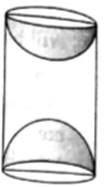A wooden article was made by scooting out a hemisphere from each end of a cylinder, as shown in the figure. If the height of the cylinder is 20 cm and its base is of diameter 7 cm, find the total surface area of the article when it is ready.

The wooden article was made by scooting out a hemisphere from each end of a cylinder
Let the radius of cylinder be r cm and height be h cm.
Height of cylinder = h = 20 cm
Base diameter of cylinder = 7 cm
Base radius of cylinder = r = diameter ÷ 2 = 7/2 cm = 3.5 cm
Lateral Surface area of cylinder = 2πrh
= 2 × 22/7 × 3.5 × 20 cm2
= 2 × 22/7 × 3.5 × 20 cm2
= 440 cm2
Since, the wooden article was made by scooting out a hemisphere from each end of a cylinder
∴ Two hemispheres are taken out in total
Radius of cylinder = radius of hemisphere
∴ Radius of hemisphere = 3.5 cm
Lateral Surface area of hemisphere = 2πr2
= 2 × 22/7 × 3.5 × 3.5 cm2
= 77 cm2
Total Surface area of two hemispheres = 2 × 77 cm2 = 154 cm2
Total surface area of the article when it is ready = Lateral Surface area of cylinder + Lateral Surface area of hemisphere
Total surface area of the article when it is ready = 440 cm2 + 154 cm2
= 594 cm2